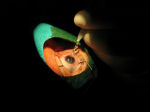Glaucoma Basics
February 15, 2009
Glaucoma is a group of diseases of the optic nerve involving loss of retinal ganglion cells in a characteristic pattern of optic neuropathy. Raised intraocular pressure is a significant risk factor for developing glaucoma (above 22mmHg). One person may develop nerve damage at a relatively low pressure, while another person may have high eye pressure for years and yet never develop damage. Untreated glaucoma leads to permanent damage of the optic nerve and resultant visual field loss, which can progress to blindness. . . .

Eye Surgery
Glaucoma can be divided roughly into two main categories, “open angle” or chronic Glaucoma and “closed angle” or acute glaucoma. Angle closure, acute glaucoma appears suddenly and often with painful side effects and so is usually diagnosed quickly, although damage and loss of vision can also occur very suddenly. Open angle, chronic glaucoma tends to progress more slowly and so the patient may not notice it until the disease has progressed quite significantly.
Glaucoma has been nicknamed the “sneak thief of sight” because the loss of visual field often occurs gradually over a long time and may only be recognized when it is already quite advanced. Once lost, this damaged visual field can never be recovered. Worldwide, it is the second leading cause of blindness. Glaucoma affects one in two hundred people aged fifty and younger, and one in ten over the age of eighty.
Learn more on Wikipedia.
Comments
Jump down to form below to submit your own comments
2 Responses to “Glaucoma Basics”
i’m afraid i have nothing new to offer. this glaucoma is very rare.
I suddenly have Acanthamoeba treatment induced glaucoma. The latest medicines which finally were working on the Acanthamoeba are PHMB combined with chlorhexidine, both Q2H. Symptoms I noticed for three days preceding my exam were occasionally seeing hundreds of small, white lights (seeing stars), sometimes a dark area such as when you look at something too bright, sore eye muscles, something not feeling right, and a sensation of increased IOP (I know they say it can’t be sensed). A phone consultation did not recommend I go in ahead of my scheduled appointment. The visual issues were thought to be new Voriconazole side effects (had been on it for a month, and the only side effect is a minor flickering of my periphery at about 15 Hz during 45 minutes peak action). After a multiple doctor exam, I was about to have new pictures taken then go home after being given a green light for the Acanthamoeba finally starting to resolve when I requested an IOP check as my eye just didn’t feel right. Shockingly, the first tonometer said 52mm, and the second 53mm!! I was told my symptoms are not typical of increased IOP. Initial treatment is 50 mg methazolamide tid, reduction of biguanide frequency to Q3H, and increase of Atropine from qd to bid.
I go in in two days. If this doesn’t work, the next step will be to try a steroid, which I understand to be controversial in Acanthamoeba therapy due to possible macrophage suppression.
If that doesn’t work, surgery and a tube on a much weakened eye as I have been on biguanides since mid October (very early detection).
Dr. Weitzner (or anyone), any suggestions would be IMMENSELY appreciated!!!!


